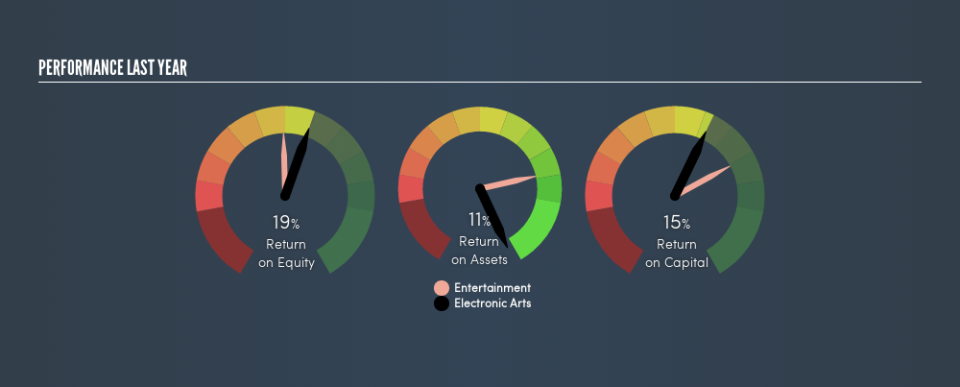Is Electronic Arts Inc.’s (NASDAQ:EA) 15% ROCE Any Good?

Want to participate in a short research study? Help shape the future of investing tools and you could win a $250 gift card!
Today we are going to look at Electronic Arts Inc. (NASDAQ:EA) to see whether it might be an attractive investment prospect. In particular, we'll consider its Return On Capital Employed (ROCE), as that can give us insight into how profitably the company is able to employ capital in its business.
First, we'll go over how we calculate ROCE. Second, we'll look at its ROCE compared to similar companies. And finally, we'll look at how its current liabilities are impacting its ROCE.
Return On Capital Employed (ROCE): What is it?
ROCE measures the 'return' (pre-tax profit) a company generates from capital employed in its business. Generally speaking a higher ROCE is better. In brief, it is a useful tool, but it is not without drawbacks. Author Edwin Whiting says to be careful when comparing the ROCE of different businesses, since 'No two businesses are exactly alike.'
So, How Do We Calculate ROCE?
The formula for calculating the return on capital employed is:
Return on Capital Employed = Earnings Before Interest and Tax (EBIT) ÷ (Total Assets - Current Liabilities)
Or for Electronic Arts:
0.15 = US$1.0b ÷ (US$9.0b - US$2.3b) (Based on the trailing twelve months to March 2019.)
So, Electronic Arts has an ROCE of 15%.
See our latest analysis for Electronic Arts
Is Electronic Arts's ROCE Good?
ROCE is commonly used for comparing the performance of similar businesses. Using our data, we find that Electronic Arts's ROCE is meaningfully better than the 9.1% average in the Entertainment industry. I think that's good to see, since it implies the company is better than other companies at making the most of its capital. Independently of how Electronic Arts compares to its industry, its ROCE in absolute terms appears decent, and the company may be worthy of closer investigation.
You can click on the image below to see (in greater detail) how Electronic Arts's past growth compares to other companies.
When considering ROCE, bear in mind that it reflects the past and does not necessarily predict the future. ROCE can be misleading for companies in cyclical industries, with returns looking impressive during the boom times, but very weak during the busts. This is because ROCE only looks at one year, instead of considering returns across a whole cycle. Since the future is so important for investors, you should check out our free report on analyst forecasts for Electronic Arts.
Do Electronic Arts's Current Liabilities Skew Its ROCE?
Current liabilities include invoices, such as supplier payments, short-term debt, or a tax bill, that need to be paid within 12 months. Due to the way ROCE is calculated, a high level of current liabilities makes a company look as though it has less capital employed, and thus can (sometimes unfairly) boost the ROCE. To counter this, investors can check if a company has high current liabilities relative to total assets.
Electronic Arts has total assets of US$9.0b and current liabilities of US$2.3b. As a result, its current liabilities are equal to approximately 25% of its total assets. A fairly low level of current liabilities is not influencing the ROCE too much.
What We Can Learn From Electronic Arts's ROCE
Overall, Electronic Arts has a decent ROCE and could be worthy of further research. There might be better investments than Electronic Arts out there, but you will have to work hard to find them . These promising businesses with rapidly growing earnings might be right up your alley.
I will like Electronic Arts better if I see some big insider buys. While we wait, check out this free list of growing companies with considerable, recent, insider buying.
We aim to bring you long-term focused research analysis driven by fundamental data. Note that our analysis may not factor in the latest price-sensitive company announcements or qualitative material.
If you spot an error that warrants correction, please contact the editor at editorial-team@simplywallst.com. This article by Simply Wall St is general in nature. It does not constitute a recommendation to buy or sell any stock, and does not take account of your objectives, or your financial situation. Simply Wall St has no position in the stocks mentioned. Thank you for reading.

 Yahoo Finance
Yahoo Finance 
